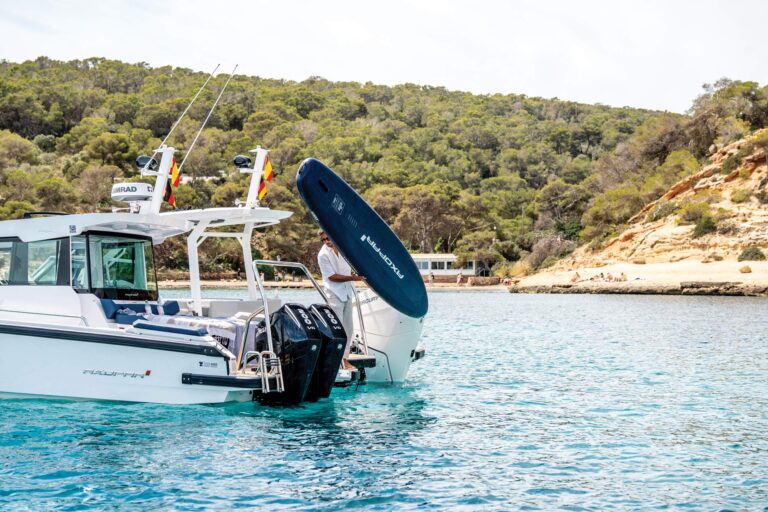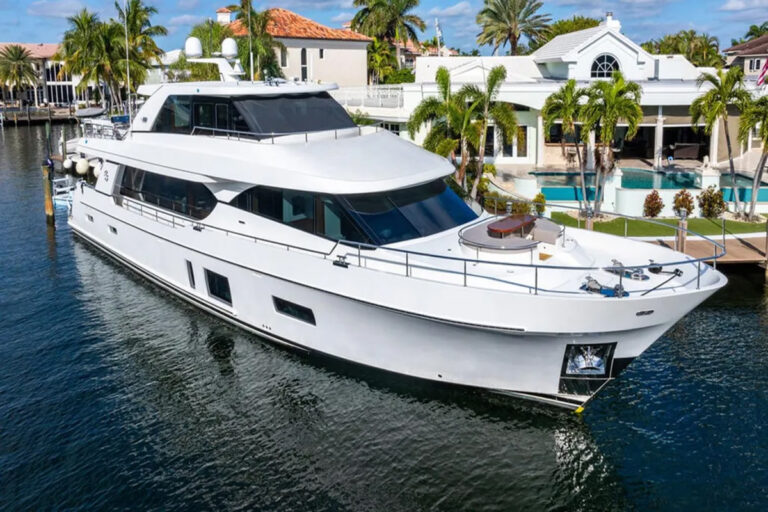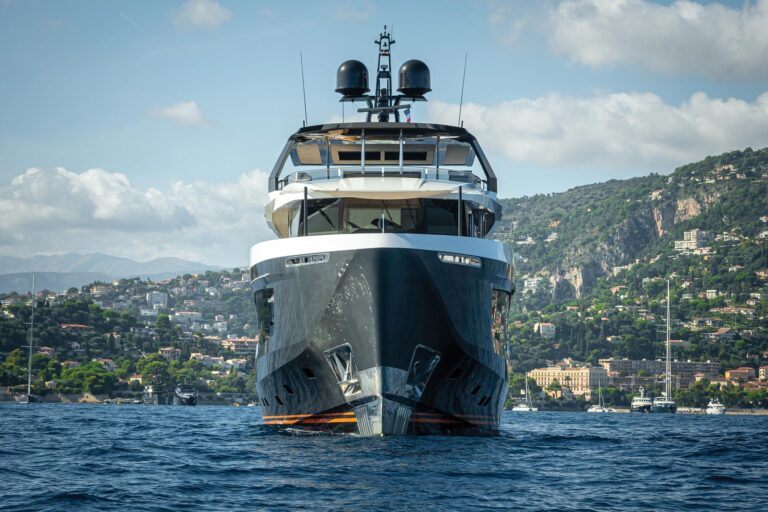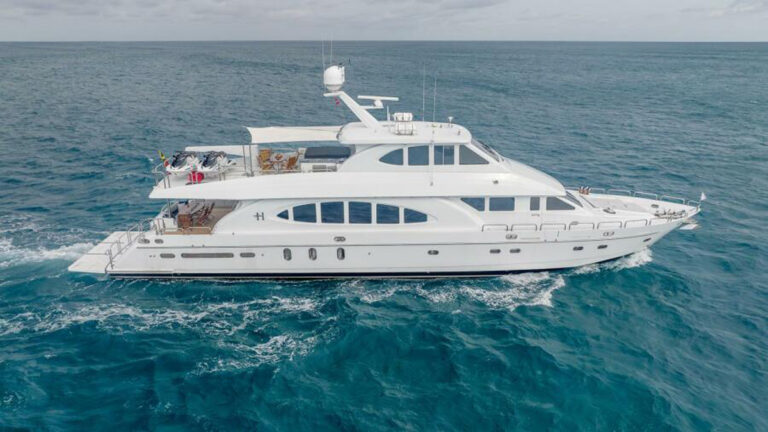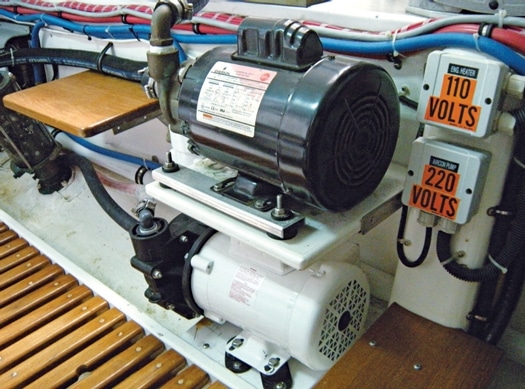
ytgaug09yctyard525.jpg
I realized early on that air conditioning is among the most important systems aboard a yacht-even 30 minutes without it can make owners or guests hot under the collar. Showers are pretty high up the necessary amenities list, too, as is ice for cocktails.
While I’m not dismissing the importance of critical systems, it’s interesting to note that, on many yachts, the majority of a cruise is spent at marinas or on the hook, not traveling. And we have come to expect the same comforts aboard as we have at home. But yacht systems are far more complex, relying on pumps to circulate or pressurize water. The water traveling through a boat is often as important as the water surrounding it. Savvy skippers keep their pumps quietly working behind the scenes, and know how to repair them quickly before onboard enjoyment comes dribbling to a stop.
Keeping Cool
Air conditioner seawater pumps work harder than most onboard systems, often accumulating 250 hours in just a two-week summertime cruise. One gulp of seaweed drifting in the marina or silt stirred up by a boat docking nearby can clog the sea strainer and shut down the system, so even meticulous maintenance right before a cruise won’t guarantee smooth operation. Most air conditioner problems are solved by clearing the strainer-a two-minute job with a spare strainer basket and a small bucket. Without a spare, it turns into a messy half-hour.
Bronze seawater pumps also fail-the metal eroded away by over half a million gallons of water pumped each month in the summer. Annual pump service heads off most problems, generally requiring a new bronze impeller every year and a new pump assembly every two or three years. Pumps still fail unexpectedly, but pump changes are simple if you have a spare pump preassembled with the proper plumbing fittings and prewired with a pigtail to attach to the nearby electrical junction box. Some boats even have a waterproof receptacle where the pump plugs in.
If seawater is flowing but the boat still seems hot, the plumbing downstream of the pump may be partially clogged with silt, making the air conditioners less efficient. Remove the hose from the seawater pump outlet and attach a garden hose connected to the dock washdown. Watch the overboard discharge to see if the 30- to 50-psi dock water pressure pushes debris overboard, and keep an eye on plumbing not typically pressurized that high.
Pressure Is On
To supply enough fresh water for washing machines, dishwashers, and multiple showers, yachts typically employ 120- or 240-volt household shallow-well pumps. Their plastic innards are quite durable, and these pumps typically provide years of trouble-free service. Unfortunately, when they run dry for more than a few minutes the heat generated distorts the plastic parts, and the only solution is to replace the pump. The good news is that most yachts under 100 feet have backup 12- or 24-volt DC-powered pumps, and can also hook directly to dockside water, but neither of these options will provide the volume of water needed to run more than two or three fixtures at once.
Household shallow-well pumps suitable to replace onboard 120- or 240-volt pumps are readily available, even at big-box retailers, but they require a bit of electrical expertise to wire correctly. Having a spare aboard, preplumbed and prewired, makes changing the pump a simple, one-hour job. In a pinch, look for an equivalent pump on a saltwater washdown system to press into service.
Shallow-well pumps have to be primed with a quart or two of water poured directly into the pump before making final hose connections. Neglecting this step will render the spare just as useless as the original pump, and this often has to be repeated a few times. A full water tank shortens the distance the pump has to draw water. Open a spigot or faucet near the pump to help water flow freely out of the pump.
Two other common problems with pressure-water systems are short cycling, where the pump turns on and off every second or two, or varying water pressure as the pump cycles. Either problem is caused by low air pressure in the accumulator tank, typically a blue or white metal canister plumbed into the hose close to the freshwater pump discharge. With the water turned off and water pressure bled, fill the air bladder inside the pressure tank to about 30 psi from the valve on the top of the tank.
Power Station
****In 20 years running yachts, I don’t recall changing more than three or four main-engine impellers because they failed while underway, yet I’ve had two- or three-dozen generator pumps fail. The reason? Generators run long after engines are shut down, sucking up abrasive silt stirred up while docking or from other boats moving nearby.
You may not miss that generator-until you’re on the hook without it. When a generator won’t pump water, check the sea strainer and belt first. If the seawater pump is the problem, changing the impeller might work, but replacing the entire pump takes about the same time. Rebuild the worn pump to be a fresh spare.
Clean Machine
****Since most yacht shower drains are below the waterline, the water is collected in a sump and pumped overboard. Head sinks and air conditioner condensate drains empty into the same sumps. The combination of soap scum, hair, and algae often clogs sump strainers, but cleaning them is simple. A spare filter speeds the process. Typically water is pumped overboard by a bilge pump and float switch. Either may fail, so prewired spares make sense.
Even if you’re not mechanical, it’s easy to find someone capable of simple repairs in most marinas. But having the right parts on hand will help get the fun flowing again.
| Additional Pump Resources Attwood; attwoodmarine.com Cal Pump, calpump.com Flojet; flojet.com Groco; groco.net ITT; itt.com Jabsco; jabsco.com Johnson Pumps; johnson-pump.com Little Giant Pump Company; www.lgpc.com Lovett Marine; lovettmarine.com March Pumps; marchpump.com Oberdorfer Pumps; oberdorfer-pumps.com Rule; rule-industries.com Sherwood; www.sherwoodpumps.com SHURflo; shurflo.com STA-RITE Industries; starite.com Verder Pumps; verder.co.za Walbro; walbro.com Wayne; waynepumps.com Whale; whalepumps.com |





